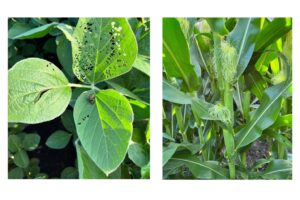Illinois Crops Update 7/15/2022
Each week, I put out a request to crops educators and specialists from the University of Illinois to compile an update to share with the entire state. We hope you find this information useful. If you have any questions or suggestions about the format or any feedback in general about these updates, please email me (harbach2@illinois.edu).
Aaron Hager, Extension Weeds Specialist, University of Illinois
Nearly all herbicide labels (soil-applied or postemergence) have rotational crop intervals that specify the amount of time that must elapse between herbicide application and planting a rotational crop. This becomes particularly important with late-season herbicide applications, and when soil moisture is limited. Additionally, the labels of almost all postemergence soybean herbicides indicate a preharvest interval or a soybean developmental stage beyond which applications cannot be made. Labels of some products may indicate both a developmental stage (before soybean bloom, for example) and a preharvest interval. Preharvest intervals indicate the amount of time that must elapse between the herbicide application and crop harvest. Failure to observe the preharvest interval may result in herbicide residue levels in the harvested portion of the crop in excess of established limits.
Talon Becker, Commercial Agriculture Extension Educator, South Central IL
With no rain in the south central Illinois region, and last week’s storms being largely scattered with variable totals, crops in the area are starting to show some stress again. This is particularly true for later planted corn, likely due to shallower roots not being able to tap into some of the deeper soil moisture. Earlier planted corn is tasseling with some silks starting to emerge. At this time, most of that corn looks relatively unstressed. With a good chance for rain showing in the forecast for this weekend, hopefully it will stay that way. Early full season beans are close to canopy and in full flower. Double crop beans have largely reached the first trifoliate stage, but growth has slowed with the dry conditions.
Doug Gucker, Local Foods & Small Farms Extension Educator, Central IL
Even though this portion of state received over 2 inches of rain in the past week, it is still rated as being in some stage of drought (abnormally dry to severe drought). Crops look much better after the rains. Most corn fields are at VT and soybeans fields at R1. At the present, reports of corn leaf diseases have been scarce in the area.

Chelsea Harbach, Commercial Agriculture Extension Educator, Northwestern IL
Planes are a-flying in western Illinois this week, which means those fungicide applications are going on in a timely manner. The weather has also been very temperate with little rain, and the outlook is hot hot hot with little to no rain. What does this mean for diseases? Well, I suspect we might have a reprieve from some of the foliar diseases that have been particularly bothersome in years past such as corn tar spot, grey leaf spot, or even Septoria leaf spot on soybeans. Time will tell, though, as disease development is 1/3 dependent on a favorable environment for the pathogen (disease triangle!). We do have one confirmed sighting of tar spot on corn in Henry County. I do know that there is more tar spot out there, but finding it can be something of an eye strain. The sheer fact is that the disease pressure just isn’t there right now and that largely has to do with the weather we’ve had and the weather outlook. I posted a write-up about understanding the tar spot disease map on corn IPM pipe. You can refer to that for more information on the subject.





